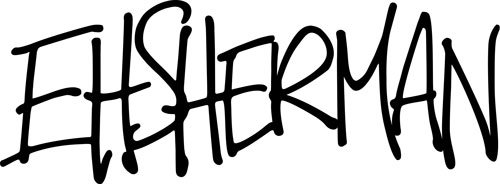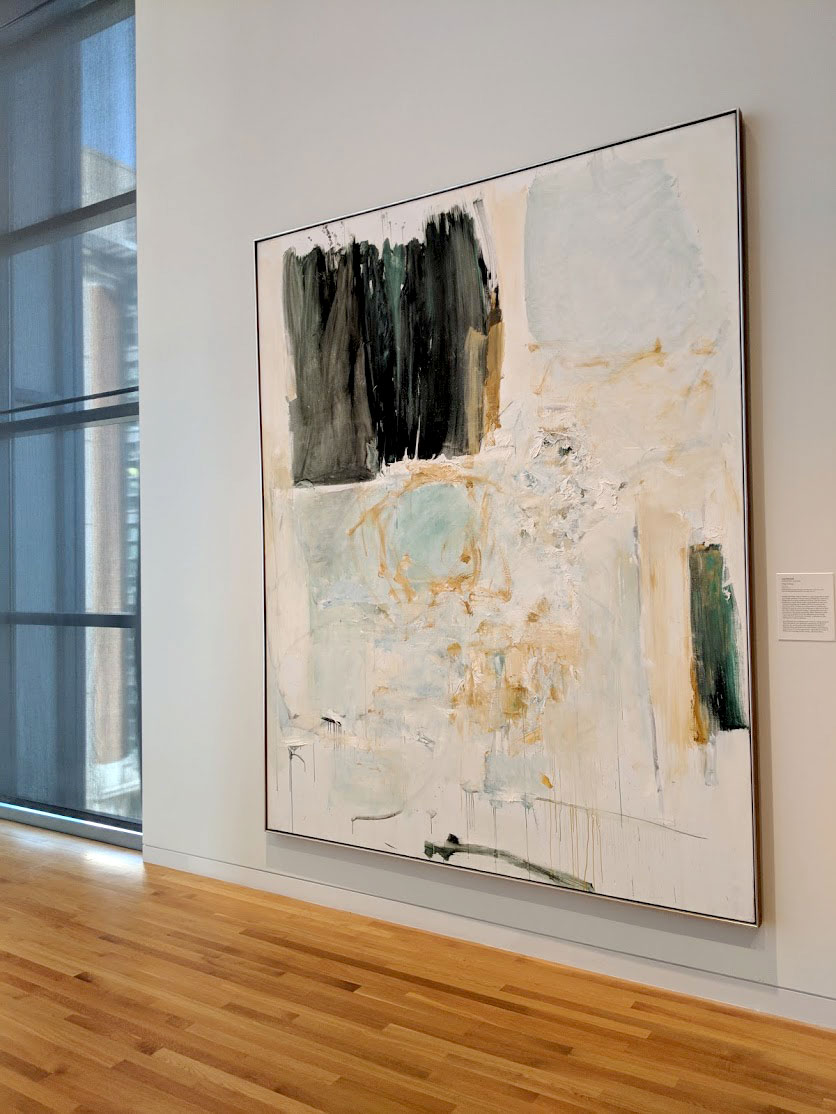How my Tools and Space Inform my Process
My favorite paintings to work on usually are borne out of two conflicting modalities; Chaos and Order.
The push and pull between the two forces drives a lot of the interaction and movement of my work - and it’s something I only “half” control.
I control the sketches, the fine details, the colors of the paints I mix - but I don’t control the way the paint moves on the surface. I don’t control the spills, the drips, the intermingling of pigment and resulting colors. Working in this intuitive way imparts a focus that I haven’t found with another process. The work is informed by the process and the process informed by the work. It’s a cyclical opposition that relies heavily on my space and tools.
My space is crooked.
My studio is in a building that pre-dates 1891 and the floors show it. There is a 2.5 inch slope from one side to the other, which doesn’t seem like much - but when you are working with water media it’s very noticeable. I absolutely could have evened the floor out, but chose to accept another facet of the unplanned; gravity was going to change my work. When I put down a pool of paint it runs downhill. I can leave it as it, or spin the work to change it’s course, but that is about the extent of my control. I can’t leave a work unattended either, as sometimes in the drying process areas of the painting will overflow into another, pushing the paint down the canvas. This has resulted in a relatively different studio experience for me - rather than leave as a work dries I now sit there (usually with another painting or some other facet of my job that needs doing - like blogging!) and literally - watch. Paint. Dry.
Sometimes I catch the drips and move the painting, sometimes I happily let them spill all the way down, grabbing other colors as it moves.
It’s another part of the chaos and I love it.
My tools also have a part to play in the balance between planned and unplanned.
Probably best characterized by my two favorites; the loose hake brush and the precise rubber wedge (or squeegee). I frequently have one in each hand and move the drying paint around with both, one making hard to control splutters of the pools, the other cutting through and leaving small, tight lines in it’s wake.
It’s in their interaction that I learned to love and embrace the dichotomy of chaos and order and begin to seek it out as I worked. And then, I saw it everywhere.
The flower growing in the crack in the cement; just a flower in a field - but here in this moment it’s transformed into something miraculous.
But I have to love it loosely. If I let myself get too caught up in the order aspect and find myself ‘planning’ the chaotic elements, I lose that magic that the flower possesses. Then the work is an exercise in making something look ‘unplanned’ and in my mind, fails at it’s purpose.
Allowing my tools and my space to contribute their essence and spirit to my process has made for a far more fulfilling and challenging studio practice.
I’d love to know more about your practice - do your tools inform your work? Does your space change your paintings? Leave me a message below!
<3
Fieldtrip: University of Michigan Museum of Art
There is a special type of calm I experience in an art museum. The smell of old paint, the hushed tones of passer-bys, knowing I'm surrounded by old, masterful work, the gentle tapping of footsteps on marble floors... it all produces a silent awe within me. While I love to explore museums in a group and hear what each individual gets out of the work, I also truly enjoy going by myself and just basking in the experience.
I had a few spare hours this afternoon and the temperature was absolutely perfect for a walk, so I headed over to the University of Michigan Museum of Art.
First off, it's an incredible building. (As referenced by how many graduates were getting their photos taken in and around the building!) The art is a smattering of different geographical and historical collections; European, American, African, Asian, Contemporary, Design, rotating exhibits... it's a wonderful assortment of powerful work.
I unfortunately only arrived about an hour before closing, so I did a speedwalk through the museum and I know I missed a few rooms. I plan to return next week for a more in-depth visit.
Rauschenberg - aquatint print
Tracey Emin
Joan Mitchell
Helen Frankenthaler
I could have spent days here and I'm so grateful to have such a fantastic museum so close. My plan is to come back and sit on the bench below the Frankenthaler for a few hours and just think... and then get to the rooms I missed today <3
Do you have a favorite museum in your city? Whats your favorite part about it?
Collage as a Sketch
When I get into the studio first thing in the morning I like to take a bit of time to wake up, drink my coffee and check -in with my plans for the day. During this time I usually doodle on spare paper, make a few quick thumbnails or throw together a collage really quick. Nothing that requires any significant thought, just a little exercise to start moving the day in the right direction.
Collage materials!
I keep a box of pre-cut, (or ready-to-be-cut) things next to my desk for specifically these times. Paint chips, magazines, old photos, print-outs, old sketches.... anything goes! I look for pattern, form, movement, anything that catches my eye or begs further exploration and cut those moments out. Once I've assembled those I start cutting further, grabbing for the essence of what drew me to them.
I really want to play with the shadows on these pots.
Materials Used:
Head over to my Amazon shop for links to all the materials:
- Canson watercolor sketchbook
-Elmers Adhesive Spray
-Derwent pastel pencils
-Ultramarine Acrylic Paint
At this point I just start playing. Layering color on pattern, adding daubs of paint, pencil lines... all that matters is I'm experimenting and staying curious.
Sometimes I take the finished collage and sketch around it, playing with color and rhythm - just expanding on the shapes found. It's a great exercise before digging into work and other projects!
I'd love to hear about your experiences with collage - how do you find the pieces you use?
My Studio Bullet Journal
Well, it's not really a REAL bullet journal. I don't have the patience to make sure everything is lined up and perfectly straight (though I WISH I did, when executed with exactness bullet journals are so, so beautiful!)
It's taken a decade or two for me to understand that if I commit to a habit, I need to have wiggle room - and while a perfectly designed and measured bullet journal might work for a few days, it's not something I'll keep up. So, messy, unmeasured journal it is.
My main focus is to break the day down into blocks for scheduling, but also keep a running tab of non time-specific to-dos. Between these two and all the extra space for notes, sketches and other blurbs I have found my holy grail for keeping the studio organized.
The physicality of the journal is super important to me. This journal isn't something that leaves my studio, and I absolutely have enough filled books already -- so the bigger the better.
This the Art Alternatives Giant Sketchbook (currently out of stock on Amazon, but I have few others listed in my shop here) and it feels like a wizard's tome. It's really heavy, but when I pull it out to plan the day and hits my table, it feels like this sacred moment before finding some ancient bit of knowledge... it engages me completely.
If you've never kept a bullet journal before, there are a bunch of great tutorials on Skillshare. To sign up follow this link and get access to their videos for 2 months for just 99 cents! I think the most important part is to find a system that clicks with the way you work and the habit will naturally take root. I couldn't commit to a perfectly measured out grid book, and I imagine in some one else may not be able to keep a book that was as scrawly and uneven as mine. Find what works for you!
If you do keep a studio journal of sorts, I'd love to see it! Comment below with an image or link of your journal, or share your organizational practices - maybe I can learn something new :)
Materials List on Amazon
I love talking art materials.
I love seeing into other artist’s bags of tricks, learning about their tools and wondering if it’s something I want to play with, something that might benefit my practice, or something I get to just be in awe of! (I'm looking at you ceramicists!) The number one question I get asked by other artists is; “Where did you find that brush/squeegee/paint color/staple gun/apron (etc)”!!!?? So I think there might be a few people out there who feel the same way I do.
I try to compile as much information on the request as I can, “where I found it, how it works, how it doesn’t work, how much is usually is….” but that can take AWHILE and I’ve been known to forget details.
Which is why I was very happy to be asked to participate in the Amazon Influencer program - providing me with a direct portal for those questions.
Instead of hunting down links, trying to remember color names or prices - I can direct these questions to my shop page where everything I use is plainly laid out and available for purchase. I usually try out new materials each time we head off on a trip, so this will be where I list those purchases as well.
There’s no additional fee to order via my shop, everything is the same price as you’d find elsewhere on Amazon - but I do get a small percentage back. Which as a full-time artist is very appreciated.
I understand those sort of situations can feel a little weird, so I absolutely wouldn’t fault anyone who wanted to find the products on their own. I choose to participate in these sorts of services as every little bit helps keep my practice going, keeps me available to answer questions, lets me work on tutorials and articles and generally just keeps this ship afloat.
Let me know if you want to see something in particular or want me to answer any questions about a specific material.
While we’re on the materials tangent, I wanted to talk a little bit about a project I started a few weeks ago that has taken on another life entirely! I started a little hashtag called #mybrushstory, (because I LOVE seeing what other artists use!) and asked for email submissions detailing the stories behind the brushes we use. Originally I had planned on using 2 - 3 entries for a little blogpost on the subject, but I was blown away by the incredible stories shared. One small post won’t do these artists and their brushes justice, so I’m trying to reimagine the project, perhaps into a series of sorts.
If you want to submit to the series, hop on over to this page for more information!
Wishing you all a wonderful day <3






















